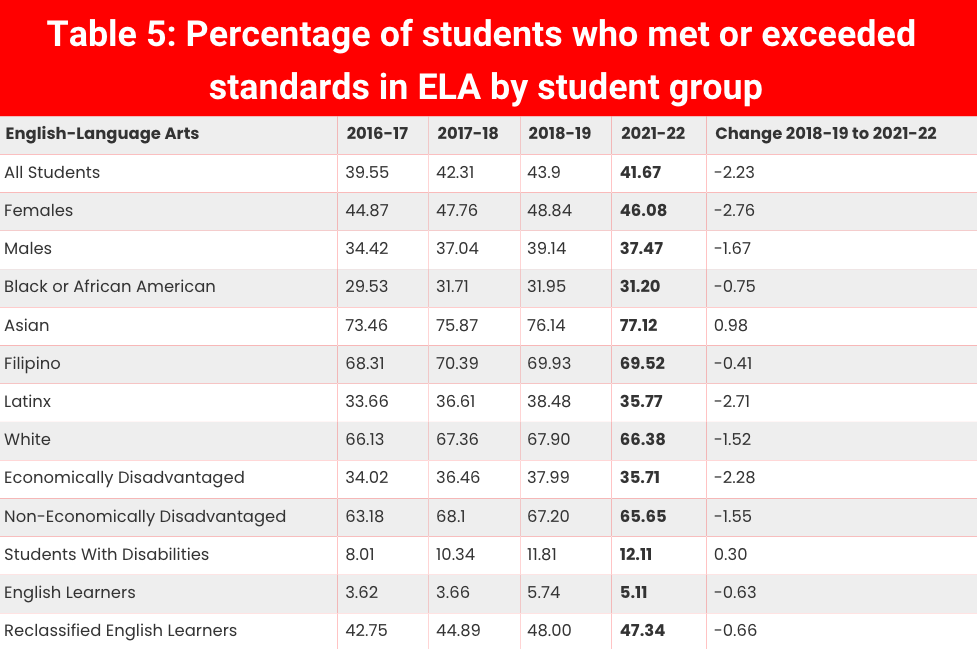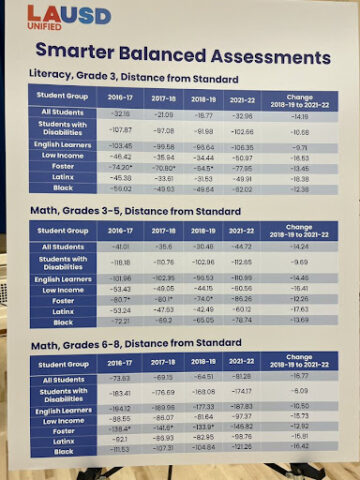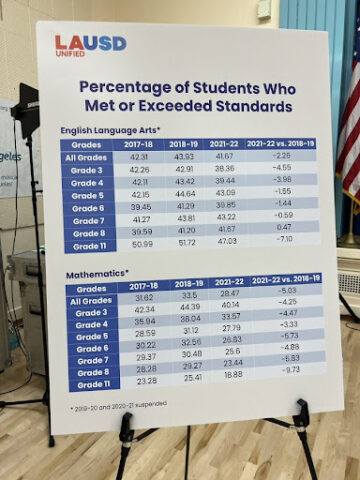Four things to know about pandemic’s detrimental effects on LAUSD test scores
Isabel Crespo | September 20, 2022
Your donation will help us produce journalism like this. Please give today.
L.A. Unified’s latest state test scores reveal dramatic decreases in student performance — and an even more striking decline for some ethnic groups and vulnerable students.
The outcomes of the 2022 Smarter Balanced assessment showed just 28.47% of LAUSD students met state standards in math, while 41.67% met English standards in the 2021-22 school year — declines of two and five percentage points respectively from the 2018-19 school year.
For Latino, low-income, Black, female, and other student groups, the declines were often greater — which was no surprise, said LAUSD superintendent Alberto Carvalho.
“Kids who were at risk, in a fragile condition, prior to the pandemic, as we expected, were the ones who have lost the most ground,” said Carvalho at a news conference. “Five years of gradual academic progress … have been reversed.”
Here are highlights from the data:
1. While all students’ test scores declined, the downward trends were greater among Latino, low income, and Black students:
The change from the 2018-019 school year to the 2021-22 school year on the English assessment for third graders was the largest among Latino and low-income students. While third graders’ scores on the English test declined 14 percentage points overall, for third grade Latino students, the drop was 18.38 percentage points; and more than 16 percentage points for low income students.
Latino and low-income students in third through fifth grade also demonstrated among the greatest change in performance from the 2018-19 school year to the 2021-22 school year in math. In those grades, Latino students’ scores declined 17.63 percentage points, while low-income students dropped 16.41%. Overall in grades 3-5, the decline was 14.24 percentage points.
The results of the sixth through eighth graders’ math scores show that Black students
exhibited the greatest change in performance, with a 16.42 percentage point decline, followed by Latino students at 15.81 percentage points and low-income students at 15.73 percentage points.
“It’s not surprising that they would have fared worse during the pandemic because of all the disadvantages they face,” said Pedro A. Noguera, dean of the Rossier School of Education at USC. “We could have predicted what we are seeing now.”
2. Females had greater declines on the math exam compared to males, a change from prior to the pandemic — and one of the largest declines in English scores:
While L.A. Unified female students have consistently performed better on the English assessments, the 2021-22 school year marked a dramatic change.
Females were among the groups that lost the most ground on reading assessments, with a 2.76 percentage point decline from the 2018-19 school year, compared to a 1.67 percentage point decline for males. Up until last school year, females routinely outperformed males in the pre pandemic years: In 2018-19, 48.84% of females met the English standards, compared to 39.19% of males.
“That is an anomaly, for over the past years, female students have actually been outperforming male students in math and science courses,” Carvalho said. “This is a regression that merits deep, deep analysis and research.”
Post-pandemic, male students earned a higher percentage in math state standards compared to females. Nearly 30% of male students met or exceeded math state standards while just over 27% of females did.
3. From 2018-19 to 2021-22, 11th graders showed a significantly larger decline on the assessments
In English, 11th graders showed the biggest drop in performance with a decrease of 7.10 percentage points compared to a decrease of 4.55 percentage points in grade three and 3.98 percentage points in grade 4.
Grade 11 also saw the greatest decline in math with a high of 9.73 percentage points away from state standards compared to 5.83 percentage points in grade eight and 5.73 percentage points in grade six.
4. Low-income students continue to underperform on state tests, with the gap between low-income and non low-income students increasing:
Recent scores in English show 35.71% of low-income students met or exceeded standards while 65.65% of non low-income students did — highlighting the growing divide between students according to socioeconomic status.
In math, 22.5% of low-income students met or exceeded state standards on math tests while 51.91% of non low-income students met or exceeded standards.
Noguera said a lack of reliable internet, access to a device, and support at home were the main drivers contributing to poor performance from low-income students.
“The general pattern in America is poor kids do less well than affluent kids and that’s because we spend less to educate the poor kids,” Noguera said. “They have less qualified teachers, they go to schools with fewer resources, and that’s true in L.A. just as it is across the country.”
This article is part of a collaboration between The 74 and the USC Annenberg School for Communication and Journalism.
Isabel Crespo is an undergraduate student at the USC Annenberg School for Communication and Journalism pursuing a Bachelor’s degree in Journalism on the pre-law track. She is passionate about ethics, education and culture.


